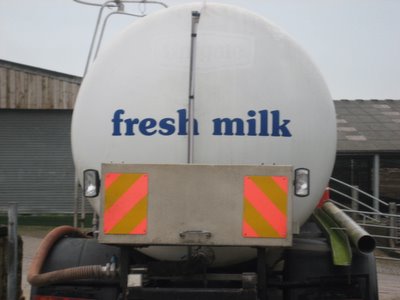 Once a fortnight one of the Neal´s Yard lorries heads out for the "Southwest Run," a daylong excursion to Somerset and beyond to pick up butter and cheese. Nearing the end of my adventure and anxious to see some farms and meet some cheesemakers, I squeezed my way into the front seat between Colin and Sam to go on last week´s run. We left London at six in the morning in hopes of
Once a fortnight one of the Neal´s Yard lorries heads out for the "Southwest Run," a daylong excursion to Somerset and beyond to pick up butter and cheese. Nearing the end of my adventure and anxious to see some farms and meet some cheesemakers, I squeezed my way into the front seat between Colin and Sam to go on last week´s run. We left London at six in the morning in hopes of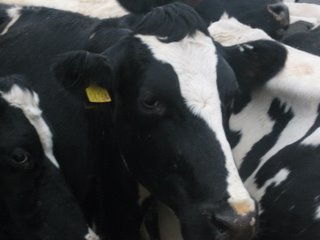 arriving at Moorhayes Farm in Somerset just after the morning milking. When we entered the drive around 8:30 a.m., we were met with the bored stares of one hundred and eighty Freisan cattle as they moseyed back to the barn.
arriving at Moorhayes Farm in Somerset just after the morning milking. When we entered the drive around 8:30 a.m., we were met with the bored stares of one hundred and eighty Freisan cattle as they moseyed back to the barn.
Inside another Tudor barn, this one re-fashioned for cheesemaking, we found George Keen and his son, Steven, draining the whey from a fresh vat of curd. George scooped up a handful of the junket and offered us a taste. Pure solidified milk, it was a far cry from the complex Cheddar it will become over the ne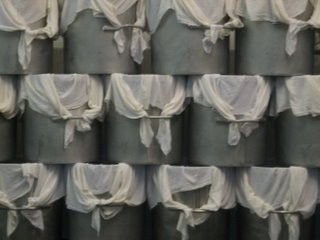 xt eighteen months. Soft-spoken and serious, George efficiently toured us through the rest of his facility: the room where the curd is milled, salted, and put into molds, where the cheese is pressed and wrapped with muslin and lard, and finally the giant storeroom where hundreds of massive cheddars wait patiently while their rinds develop a carpet of mold. Though the cheesemaking areas were renovated and expanded recently, the Keens´ recipe goes back generations - as the old copper cheese vat in the kitchen will attest.
xt eighteen months. Soft-spoken and serious, George efficiently toured us through the rest of his facility: the room where the curd is milled, salted, and put into molds, where the cheese is pressed and wrapped with muslin and lard, and finally the giant storeroom where hundreds of massive cheddars wait patiently while their rinds develop a carpet of mold. Though the cheesemaking areas were renovated and expanded recently, the Keens´ recipe goes back generations - as the old copper cheese vat in the kitchen will attest. 
George had more cheese to make and we more stops to reach, so we grabbed our butter and headed back to the motorway. Sadly, our itinerary did not include a stop at Manor Farm, where Jaime Montgomery makes his hallowed cheddars, but from the road we were able to look up at his majestic home and its surrounding fields. (Stonehenge wasn´t a stop either, but we were able to gawk at it in passing too).
Following a couple of expedient stops for butter pick-ups and a hearty English breakfast, we drove to Village Maid in Riesely where Anne and Andy Wigmore make ewe and cow´s milk cheeses with milk sourced from area farms. Monger Chris George likes to tell people the Wigmores make cheese "in the shed behind their house," which is not much of an exaggeration. All of their cheesemaki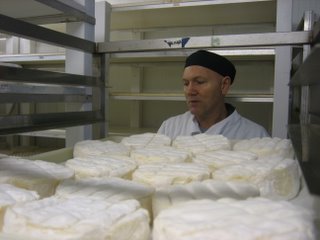 ng, sanitizing, and storage takes place in a few cramped rooms. When we arrived, Andy was just putting the latest batches of Wigmore and Waterloo to rest in preparation for brining.
ng, sanitizing, and storage takes place in a few cramped rooms. When we arrived, Andy was just putting the latest batches of Wigmore and Waterloo to rest in preparation for brining.
Compared to the Keens and Montgomerys, the Wigmores are relatively new to cheesemaking. Andy is a former journalist and Anne a scientist who has long studied cheese. They previously had an arrangement with the Duke of Wellington to make cheddar from the milk of his Guernsey herd, but after trials and tribulations over the cheddar they opted for their own cheeses: Wigmore, Waterloo, and Spenwood. The antique cheddar press still remains, however, rusting away in the shed.
With the lorry full, we were on our way back to the Arch - a bittersweet journey for me as it signaled the end of my time at Neal´s Yard.
But, then again, Spain was on the horizon . . .

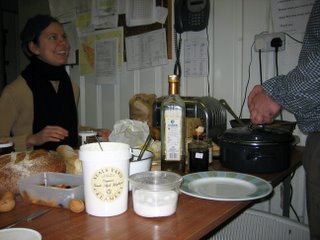

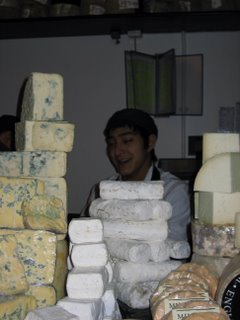
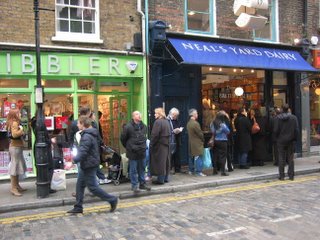



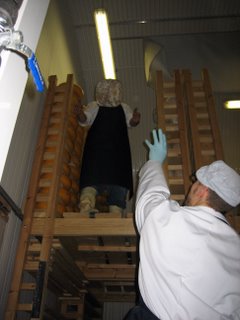



 until it becomes deliciously brown and bubbly. He then scrapes it over potatoes and gherkins. He also serves toasted cheese sandwiches (featured, by the way, in the New York Times).
until it becomes deliciously brown and bubbly. He then scrapes it over potatoes and gherkins. He also serves toasted cheese sandwiches (featured, by the way, in the New York Times).





